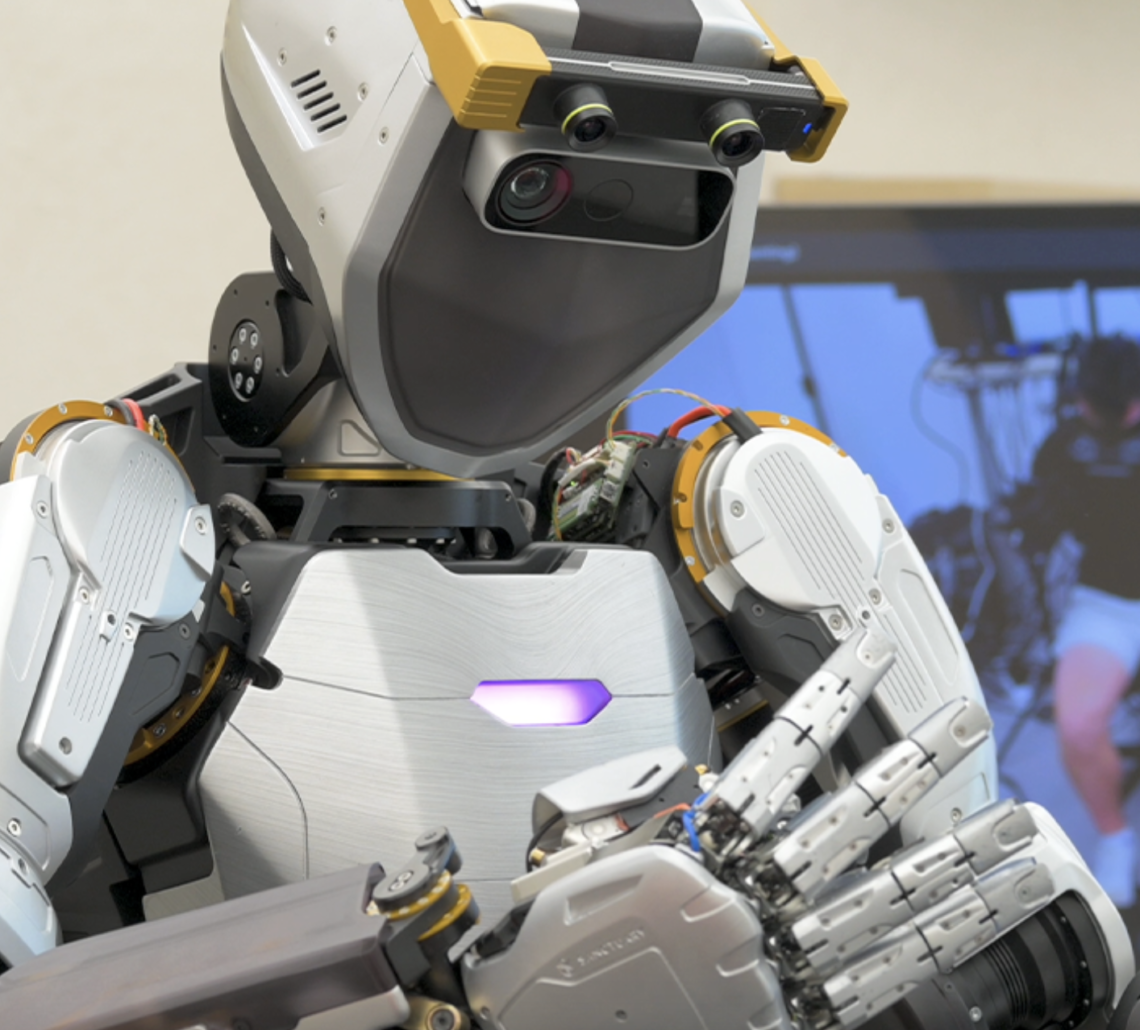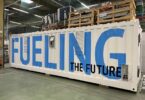On March 18 Nvidia, the U.S. maker of advanced AI chips, systems, and software, announced GROOT, a foundation model for humanoid robots, a development that underscores how quickly human-like robots that include generative artificial intelligence features are advancing.
The worldwide market for humanoid robots is forecast to be bigger than analysts in Goldman Sachs Research expected even a year ago. The prospects for machines that help with everything from folding laundry to handling hazardous waste have improved as progress in artificial intelligence accelerates and investment in the sector grows faster than anticipated. The total addressable market for humanoid robots is projected to reach $38 billion by 2035, up more than sixfold from a previous projection of $6 billion, according to the Goldman Sachs report.
“I think we are still a little way from the tipping point since we don’t yet have a low-cost platform at scale,” says robotics and AI expert Dr. Ayanna Howard, the Dean of Engineering at Ohio State University and Monte Ahuja Endowed Dean’s Chair. “I think we are about a year to three years away from that. When we get there, these robots will begin to displace the factory floor’s lower skill manual jobs, but it will not yet replace the knowledge worker, at least not immediately.” (For more of Howard’s views on the evolution of AI-powered robotics read The Innovator’s Interview Of The Week.)
Given the potential impact on jobs its no surprise that on March 28 the Robotics4EU project published a Responsible Robotics Advocacy Report that outlines a strategy for promoting responsible robotics development in the European Union. The report talks about the impact on the workforce and underscores the need for a distinct approach to physically embedding intelligent systems into robotics solution as there are fundamental differences between robotics and AI systems, particularly in areas such as safety, privacy, cyber-security, and sustainability.
An Inflection Point That Could Change Labor Forever
Robots powered by GROOT (short for “Generalist Robot 00 Technology) will be designed to understand natural language and emulate movements by observing human actions—quickly learning coordination, dexterity, and other skills to navigate, adapt and interact with the real world, Nvidia said in its March 18 announcement.
The new platform will consist of a computer system that will power the robot and AI, plus a package of software including genAI and other tools in order to build robots that are human-like, the company said at its annual developer conference.
The powerful computer behind the genAI software is called the Jetson Thor and is based around one of the company’s AI chips and other hardware. Th computer will give a robot enough computing horsepower to perform complex tasks and interact with people and machines, the company said.
“Building foundation models for general humanoid robots is one of the most exciting problems to solve in AI today,” Jensen Huang, founder and CEO of Nvidia said in a statement. “The enabling technologies are coming together for leading roboticists around the world to take giant leaps towards artificial general robotics.”
Indeed, on March 11 Agility Robotics, creator of a human like Mobile Manipulation Robot (MMR) called Digit, which is being tested by Amazon and GXO Logistics unveiled a cloud automation platform for deploying and managing fleets of robots. The new platform, Agility Arc, is a cloud-based tool that’ll be able to command a robot army. The company is planning a “robots as a service” model, in which it’ll charge customers a monthly fee for their Digit fleet.
Agility is opening a manufacturing facility in Oregon called RoboFab, with plans to eventually produce 10,000 two-legged robots annually. It has just hired Peggy Johnson as its new CEO. Johnson, who formerly held top executive positions at Qualcomm and Microsoft, was most recently CEO of Magic Leap.
“We are at an inflection point in history, with human-centric robots like Digit poised to change labor forever,” Jonathan Hurst, co-founder and chief robot officer at Agility Robotics said in a press statement. It is one of a number of robotics companies planning to use Nvidia’s AI platform.
“Embodied AI will not only help address some of humanity’s biggest challenges, but also create innovations which are currently beyond our reach or imagination,” Geordie Rose, co-founder and CEO of Sanctuary AI, another robotics company that plans to use Nvidia’s AI platform, said in a statement. “Technology this important shouldn’t be built in silos.”
In another March development The Open Source Robotics Foundation launched the Open Source Robotics Alliance (OSRA), a new initiative aimed at supporting open source robotics projects, with a particular focus on the OSRF’s own robot operating system (ROS). First released in 2007 ROS has played a foundational role in robotics development for decades. It is now owned by Alphabet, Google’s parent company.
In 2023 Open Robotics, which is the organization that includes the nonprofit Open Source Robotics Foundation (OSRF) as well as the for-profit Open Source Robotics Corporation (OSRC), was acquired by Intrinsic, a standalone company within Alphabet that is developing software to make industrial robots intuitive and accessible.
Intrinsic is a spin-off of X, Alphabet’s moonshot factory. Its mission is to “democratize access to robotics” through software tools that give traditional industrial robots “the ability to sense, learn, and automatically make adjustments as they’re completing tasks.” Intrinsic is focused on the software side, relying on learning techniques and simulation to help industrial robots adapt and scale in a way that won’t place an undue burden on industries that may not be used to flexible automation. Intrinsic has also acquired intelligent automation startup Vicarious, which had been working on AI-based approaches to making robots “as commonplace and easy to use as mobile phones.”
Meanwhile, in late February Figure, a startup working to build humanoid robots that can perform dangerous and undesirable jobs, raised $675 million at a $2.6 billion valuation from investors including Amazon founder Jeff Bezos, Nvidia and Microsoft. Figure, which claims its robot can now “have full conversations with people on end-to-end neural networks” announced in January announced a deal with automotive maker BMW. Under terms of the deal BMW will identify initial use cases to apply the Figure robots in automotive production. Once the first phase has been completed, the Figure robots will begin staged deployment at BMW’s manufacturing facility in Spartanburg, South Carolina.
Tesla, robotics company Boston Dynamics and Sanctuary AI, which says it is on a mission to create the world’s first human-like intelligence in general-purpose robots, are among others racing to build humanoid robots.
In January Norway’s humanoid robot startup IX Technologies announced a $100m Series B funding round, led by EQT Ventures. OpenAI and Tiger Global invested in its Series A last year. 1X,’s first-generation android, named EVE, is a wheeled android built to work alongside human teams in the logistics and retail sectors. The company says EVE robots are strong enough to move shipments but gentle enough to handle fragile items. A human operator can control a fleet of up to 15 EVEs, tap into their cameras and control their movement from a distance.
IX said the latest influx of capital will be used to launch a new robot called NEO, tailored for everyday domestic tasks for consumers. NEO can walk, jog, climb stairs, and navigate spaces naturally.
One Robot Per Person?
If pundits are right, it won’t be too long before robots will become more ubiquitous both in the workplace and at home.
In an article entitled “One Robot Per Child” published on Medium this week, American-Norwegian computer scientist and technology entrepreneur Hans Peter Brondmo, until recently the leader of Google X ‘s Everyday Robots project, described a future in which every adult would own a robot that would act as a hard-working, highly capable real-world robot twin. Each robot would exist in the physical world, and it would also have a virtual twin; like a personal supercharged ChatGPT agent. “You would get your robot for free,” he wrote. “It gets free maintenance, free power — it’s charged by the sun — and free upgrades. Even better, whatever money your robot makes, is yours. You’ll pay taxes on your income just like today, whether it’s brought home by the robot, you, or both. It would likely become necessary to regulate robot ownership. For example, robots would be non-transferable. A vibrant robot service marketplace and economy could evolve. Robots and their virtual agents will work in factories, hotels, hospitals, schools, call centers, retail stores, restaurants, offices, banks, creative agencies… pretty much anywhere people work now… and then some.”
These AI-powered robots will be inherently disruptive, says Brondmo. “Now is the time to prepare for a future where what defines us as being human is inevitably going to change.”
IN OTHER NEWS THIS WEEK
ARTIFICIAL INTELLIGENCE
U.S. Tech Giants Move To Concentrate Their Industry Dominance
Microsoft announced that it has hired Mustafa Suleyman, the cofounder of $4 billion AI startup Inflection, to run Microsoft’s AI operations. Karén Simonyan, another Inflection cofounder, is also joining Microsoft, along with an unspecified number of staffers. Suleyman is the co-founder of DeepMind, which was acquired by Google in 2014. With Suleyman’s move and Google’s AI division being led by his DeepMind co-founder Demis Hassabis, two former members of the pivotal AI startup are now playing key—and competing—roles at tech giants locked in an AI race.
Meanwhile, Amazon said it has invested $2.75 billion more in the artificial-intelligence startup Anthropic, a major investment from a tech giant looking to compete with Microsof, Google and others in the AI arms race. Amazon has now invested a total of $4 billion in Anthropic after making a $1.25 billion initial investment in the company in September. The company said at the time that it could invest up to $4 billion. Amazon said it has a minority ownership position in Anthropic. The funding marks Amazon’s largest investment in another company since the online retailer was founded nearly 30 years ago.
Google agreed last October to invest up to $2 billion in Anthropic.
The Federal Trade Commission said in January it is probing investments and partnerships made by the biggest technology companies and how they affect the competitive landscape for AI systems, which have developed the ability to perform tasks such as conversing, generating photos and writing computer code.
CYBERSECURITY
U.S. Publishes Draft Rules For Cyber Incident Reporting
The U.S. Cybersecurity and Infrastructure Security Agency (CISA) published long-awaited draft rules on how critical-infrastructure and companies vital to a particular sector must report cyberattacks to the government. CISA developed the rules after President Biden signed the Cyber Incident Reporting for Critical Infrastructure Act into law on March 15, 2022. Officials hope reports from companies in a range of industries will allow them to better spot attack patterns and determine tactics used by cybercriminals and nation-states to help improve defenses, reports The Wall Street Journal. Under the rules, companies that own and operate critical infrastructure would need to report significant cyberattacks within 72 hours and report ransom payments within 24 hours. The rules apply to any company owning or operating systems the U.S. government classifies as critical infrastructure, such as healthcare, energy, manufacturing and financial services. The rules will also apply to companies that don’t operate critical infrastructure, but whose systems may be vital to a particular sector, such as service providers.
U.S. Government Offers $10 Million Reward For Info On Ransomware Gang Targeting U.S. Critical Infrastructure
The U.S. State Department on March 27 offered up $10 million for information on the “Blackcat” ransomware gang which hacked The UnitedHealth Group’s tech unit, impacting insurance payments across America. UnitedHealth said last week it was beginning to clear a medical claims backlog of more than $14 billion as it brought its services back online following the cyberattack, which caused wide-ranging disruption starting in late February. UnitedHealth’s tech unit, Change Healthcare, plays a critical role in processing payments from insurance companies to practitioners, and the outage caused by the cyberattack has in some cases left patients and doctors out of pocket.
U.S. And UK Charge State-Backed Chinese Hackers
Hackers linked to the Chinese government launched a sweeping, state-backed operation that targeted U.S. officials, journalists, corporations, pro-democracy activists and the U.K.’s election watchdog, American and British authorities said this week, in announcing a set of criminal charges and sanctions. The intention of the campaign, which officials say began in 2010, was to harass critics of the Chinese government, steal trade secrets of American corporations and to spy on and track high-level political figures, reports the Associated Press. Western officials disclosed the operation, carried out by a hacking group known as APT31, while sounding a fresh, election-year alarm about a country long seen as having advanced espionage capabilities.The U.S. Justice Department charged seven hackers, all believed to be living in China. The British government, in a related announcement, imposed sanctions on a front company and two of the defendants in connection with a breach that may have given the Chinese access to information on tens of millions of U.K. voters held by the Electoral Commission.
To read more of The Innovator’s News In Context stories click here.






